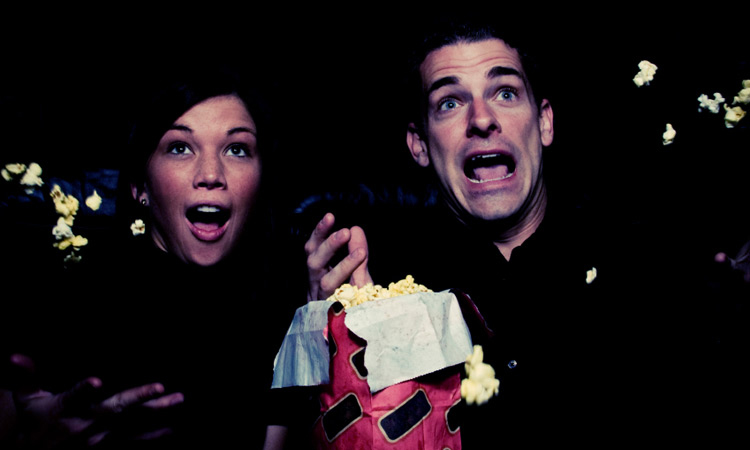There was a phase in high school that I loved nothing more than a good juicy horror flick. I loved the feeling of fear, trepidation and shock. More than that, I loved knowing that I could handle it. Embodying the terror and then releasing it supplied an adrenalin rush that was hard, in our sleepy hamlet of a suburban town, to access in the real world. Sponging up the suspense and then springing from the dark theater into an overlit lobby I felt victorious. Bring it on Cugo, Norman Bates, Regan MacNeil, Jack Torrence, Pennywise, Freddy Kreuger and Jason Voorhees—I can survive!
According to one of my favorite science writers, Sharon Begley, in a terrific article entitled, Why Our Brains Love Horror Movies, there are a variety of reasons that (teens in particular) love the concentration of fear that horror films provide, including:
The old-school reason (promoted by Freud and Jung) espouses the value of catharsis. John Edward Campbell, an expert in media studies at Temple University, explains, “The pleasure comes from the relief that follows. It provides a cathartic effect, offering you emotional release and escape from the real world.”
The new-school reason (supported by modern scientists exploring non-cathartic motivations) is the predictability of the story and its resolution. In a 2004 paper clinical psychologist Glenn Walters of Kutztown University posited that, “Control lost under the cover of darkness is rediscovered in the light of day; danger posed by things unknown is reduced by increased knowledge and predictability. [Audiences] can either succumb [to frightening images] or learn to manage…. By learning to suppress feelings and display mastery or cling to others in a dependent ploy for protection, a person learns to cope with another aspect of his or her environment, a skill that may be useful in dealing with more than just horror pictures.”
Indeed, my own love of horror flicks began (probably not coincidentally) after a horror I survived as an adolescent; shortly afterward I began seeking experiences that would help me (ahem, cathartically) process the real-life fear I had felt in the past and reduce my fear of such horror occurring again in the future. Horror films were a natural fit for the emotionally exhilarating and physically unnerving psychological arc I was trying to create for my own personal narrative. That arc is a natural human need no matter what experiences lurk in each individual past.
How fearful concentration happens
The results of a recent study published in the journal Neuroscience further explain how horror films work their bloody magic on the brain. Seeking to discover the way suspense affects the brain researchers from the Georgia Institute of Technology studied subjects’ reactions to scenes from ten classic horror films, including Alfred Hitchcock’s North by Northwest and The Man Who Knew Too Much, plus Alien and Misery. What they discovered is that when the story’s narrative becomes most tension-filled the brain responds by narrowing vision and tightly focusing attention.
To test subjects’ brains researchers measured attention by tracking (via MRI) the amount of activity in the part of the brain most responsible for processing visual stimuli, the calcarine sulcus. Results revealed that activity decreased in the calcarine sulcus’ peripheral visual area during high-suspense moments. Instead, more concentration was devoted to the region responsible for central processing. Translation: During suspenseful scenes the brain focused in a way that prioritized processing critical information only while consequently ignoring secondary/peripheral information.
Associate professor Eric Schumacher points out that this is “… a neural signature of tunnel vision. During the most suspenseful moments, participants focused on the movie and subconsciously ignored the [visual information around the edge of the screen]. The brain narrowed the participants’ attention, steering them… into the story.”
To the study’s lead author, Matt Bezdek, this explains why when we feel we get lost in a story, the theater and people around us seem to disappear. “Now we have brain evidence to support the idea that people are figuratively transported into the narrative,” Bezdek concludes.
While it may seem from the outside that horror films are nothing more than horror, research and hypotheses combine to suggest that they offer an experience for both the mind and brain to practice—in a safe space—how to respond to unsafe moments. Begley explains that “…horror films are popular because they speak to the basic human condition of existential fear, the knowledge that we are all doomed…” thereby allowing us to face our greatest fear.
So, staring down and then escaping a rabid dog, an axe-wielding husband, a hockey-masked stalker or a man with a freaky set of nails is more than entertaining; it’s survival brain training Hollywood-style.
Click here to get inspired by Rose’s easy steps to positively change your mind



